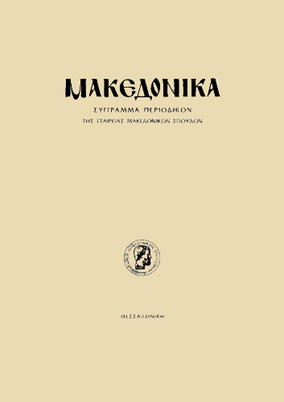Φορολογικές κατηγορίες των χωριών της Θεσσαλονίκης κατά την Τουρκοκρατία
Part of : Μακεδονικά ; Vol.20, 1980, pages 375-462
Issue:
Pages:
375-462
Section Title:
Articles
Abstract:
The purpose of this article is to investigate the villages in the area (kaza) of Thessaloniki under the financial and administrative system of the Ottoman state. This research is based mainly on the Turkish documents kept in the Historical Archives of Macedonia, Thessaloniki.During the 15th-16th centuries the "kaza” of Thessaloniki had been organized according to the Ottoman financial system of that time. A large number of villages became "timars” under Bayezid I. We do not possess adequate hiformation to locate these villages, but we can use two "tahrir defterleri”, containing the names of villages belonging to timars. Of these defters kept in the National Library at Sofia, Bulgaria, the first was written before December 1445 and the second at the end of the 15th century. Several entries are dated from the time of Bayezid I and Mehmed I.Another large number of villages was inhabited by Turks, known as Yüriiks (nomads) or Evladi Fatihan (children of the conquerors). Some of them had settled in villages abandoned by their Christian populations when the Turks were conquering Macedonia at the end of the 14th century; others had been later forced to emigrate there by Murad I and Bayezid I. These Yürüks were organized as auxiliary corps, serving in military campaigns. They were exempted from certain taxes and were given small areas to cultivate (chifliks). A catalogue of these villages has been published by Μ. T. Gökbilgin; several lists of the same villages appear in the books of the "kadis” of Thessaloniki (sidjils).A large area west of Thessaloniki and between the great rivers Aliakmon (Karasu) and Axios (Vardar), containing a considerable number of villages, belonged to the «wakf», i.e. the pious endowment of Gazi Evrenos Bey. He had founded the town of Yenidje Vardar about 1372 and thence he and his followers fought incessantly for the conquest of Macedonia and Southern Greece. Bayezid I and his successor were obliged to let Gazi Evrenos keep the area he had occupied; they did not distribute it to the sipahis as timars and Gazi Evrenos made it a vast wakf. The villagers, both Moslems and Christians, paid their taxes to the wakf. The number of the Christian inhabitants was very limited at the end of the 15th century, but it must have increased during the next two centuries.During the 17th-18th centuries or even earlier the villagers were obliged to render certain services to the state or to give several taxes to it in kind. Early in the 18th century the Ottomans started demanding payment in cash, but services were still asked for on certain occassions. The villages were divided into categories, according to those services, although they belonged to the Gazi Evrenos wakf or to a timar as well. Thus there were the villages of the Kömürkesan, who gave charcoal to the state, of the hanekesan, who gave saltpetre and paid the taxes «avariz» and «bedeli nuzul», of the tuzciyan, who worked at the salt-works, of the koruciyan, who took care of the state-owned pasture-lands and raised camels, horses and mares for the army; other categories were villages which belonged to the wakf of Ishak Pasa, or to the wakf of Gazanfer Aga. This last one was Chief of the White Eunuchs in the Palace (Babii’s Sa’adet Agasi) at the end of the 16th century; he had turned all the villages in the peninsula of Cassandra into a wakf. Another category consisted ofthe villages belonging to the «hass» of Langaza or Longoz (Sithonia), whose revenues were for the Chief of the Black Eunuchs of the Imperial Harem (Darii’s-sa’adet Agasi or Kizlar Agasi). The third peninsula of Chalkidiki, MountAthos, was a hass of the Chief-Gardener (Bostanci-basi), who was also the chief of the palace-guards and chief executioner. Among the villages of the Kömürkesan there were those of Sidrekapisi or Μαντεμοχώρια, whose inhabitants worked in the state-owned silver mines in Eastern Chalkidiki. Finally there were three villages, which cleaned and dyed the woolen clothes made in Thessaloniki for the janissaries.Representatives of each village gathered together and decided how much of the total amount of a tax each village would pay, according to its population. All the inhabitants of a village were responsible for the payment of their dues to the state. We can say that in the 18th century the levied unit was not the family (hane) anymore as it was earlier, but the village. The onerous taxation obliged the villagers to borrow large sums of money from Turkish or Jew ish money-dealers at high rates of interest. Later, the villagers, being unable to pay both the taxes and their debts, either abandoned their villages or sold them to their creditors. Thus a large number of previously free-owned villages became estates of great land-owners. We can follow this procedure in several documents. The situation created is clearer in a register of 1861, in which we can see that more than half of the Christian villages had become chiftliks. A great number of them belonged to the Gazi Evrenos wakf, while many villa ges in Chalkidiki had become possessions of the monasteries of Mount Athos (μετόχια).These conditions encouraged the accumulation of large amounts of capital and the cultivation of one kind of crop, mainly a cereal ot cotton, until the Balkan wars of 1912-1913 and the liberation of Macedonia from the Turks·
Subject (LC):
Notes:
856:https://ejournals.epublishing.ekt.gr/index.php/makedonika/article/view/5974, DOI: https://doi.org/10.12681/makedonika.413
Electronic Resources:




